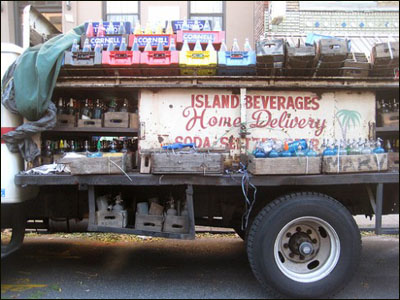Back here, I linked you to an article about the history of Royal Crown Cola and Diet-Rite Soda. This brought a string of e-mails from my friend of way-too-many years, Joe Brancatelli. Joe is a world class expert on airlines and air travel but it turns out he knows a thing or three about sodas, too…
Because we both love this arcane stuff, some commentary about the RC Cola story to which you linked…
1) The author got it wrong with the history of No-Cal, which inspired Diet-Rite. The Kirsch family had been in the beverage business since the turn of the 20th century. It was the soda we drank, in fact. Why? Because it was delivered by the "seltzer man," who came to your house and delivered seltzer in siphons, beer and carbonated beverages. Our seltzer guy carried Kirsch beverages. Others were aligned with Hoffmann or Cott. And as you might have expected, all these brands were created by Jewish immigrants from Russia or Poland or elsewhere.
I never drank Coke or Pepsi as a kid. Kirsch was the brand in our house and there was cola and orange and lemon-lime and root beer. You bought by the case, in 32 ounce bottles, along with cases of seltzer and beer. The Kirsch family invented No-Cal not because they were doctors tied to a sanitarium. They were entrepreneurs who made money selling beverages and they endowed the sanitarium, then created No-Cal as a sideline of the sanitarium. All the Jews and Italians who emigrated to the US in the great diasporas made money, then felt compelled to give back…
2) Weirdly, early in my career, I worked at Home Furnishings Daily as part of Fairchild (also publisher of Woman's Wear Daily, Footwear News, etc.) and the RC Companies were extremely profitable in furnishings. It was what you did in the 1970s. You diversified into a conglomerate. IT&T owned telephones, Sheraton hotels and an air conditioning company. Burlington Industries owned textile makers and furniture companies. Gulf + Western (forever Engulf and Devour, of course) owned furniture companies. Singer owned sewing machines and furniture companies. Those were the days of horizontal corporations. Out of favor now, of course, but big in its time (1960s to late 1970s…)
And then Joe sent me an obit he found online for Morris Kirsch, It's from June 25, 1986 and it says in part…
Morris Kirsch, the retired chairman of Kirsch Beverages, which 30 years ago introduced the nation to sugar-free soda under the No-Cal label, died last Thursday at Mount Sinai Hospital in Miami Beach. He was 79 years old and lived in Bay Harbor Islands, Fla.
Kirsch Beverages Inc. goes back to 1904, when Mr. Kirsch's father, Hyman, opened shop in the seltzer-drinking town that was Brooklyn to acquaint the natives with the fruit-flavored sodas he had learned to make in the Crimea, where he was born. Horse-drawn buggies bearing a few cases of his bottled sodas joined the stream of seltzer wagons, people approved, and the Kirsch family prospered. Morris Kirsch joined his father in the business in 1926 and became president about 15 years later.
The Kirsches' development of No-Cal stemmed from their civic work at a sanitarium for chronic diseases, many of whose patients were diabetics who could find no sugar-free, nonalcoholic beverage.
The Kirsches repaired to the company laboratory where, with their researcher, Dr. S.S. Epstein, they looked for a synthetic sweetener that would not leave a metallic aftertaste. They found it in cyclamate calcium.No-Cal started modestly in local distribution in March 1953, when it appeared at dietetic counters. But the company soon realized that general customers, too, were buying the new sodas. Its advertisements then targeted weight-conscious Americans everywhere, and diet drinks took flight. The Government ordered cyclamate off the shelves in 1969, but by then No-Cal and its larger competitors were ready to substitute with other sugar-free solutions.
And then Joe sent me this photo and the accompanying text…

Dug up (thank you, internet) a picture of what a seltzer-delivery truck used to look like. There were hundreds of these guys working the east coast cities. They made their living selling cases (10 bottles each) of seltzer, but expanded to soda (brands like Kirsch and Hoffman and Cott) and beer. Notice this truck has the soda bottles lashed to the top. That's pretty much as it was.
Your seltzer man was literally part of the family. Our guy when I was growing up, Selig Berkowitz, sold not only to my family, but also my grandparents on both sides. (We all lived within 20 streets of each other, of course…)
In my days growing up in Brooklyn, we also had two bakery companies making deliveries (Kruge's and Dugan's), the milkman, of course, a knife sharpening truck and, naturally, the guy who delivered snacks called Charles Chips and Charles Pretzels in big, tin drums!
This of course intrigues me because Joe is close to my age and we had nothing of the sort in West Los Angeles. We had the Helms Bakery Trucks and we had ice cream vendors, of course, as well as Sparklett's or Arrowhead water delivery. But no seltzer men going door-to-door…and a lot of areas didn't even have milkmen. Apparently in L.A. in the late fifties and early sixties, supermarkets were catching on to the extent that it wasn't economically feasible for diary companies to service some communities. That's what soon did in the Helms Trucks.
By the way: Until I was about ten, I didn't realize that seltzer was a beverage. I thought it was only to be used to spray in someone's face. Honest. Thanks, Joe.